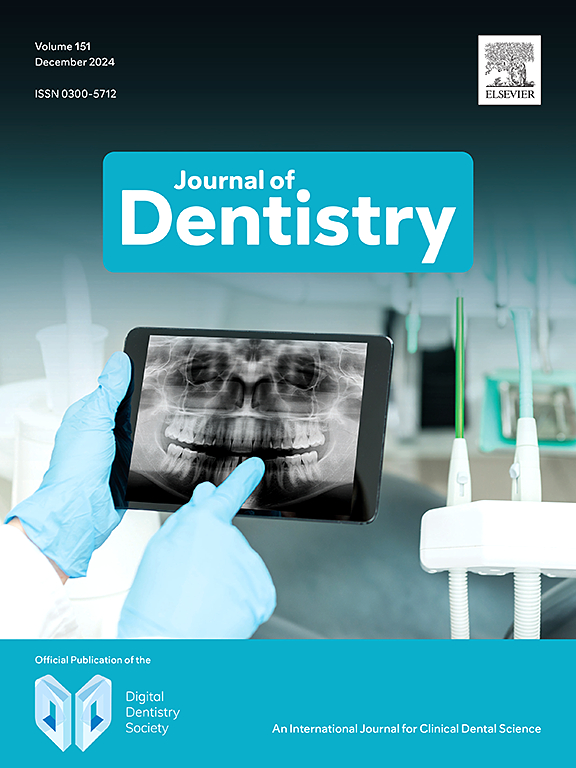In vivo prospective randomised study of the wear of dental restorations using an intraoral scanner and its correlation with visual assessment.
IF 4.8
2区 医学
Q1 DENTISTRY, ORAL SURGERY & MEDICINE
引用次数: 0
Abstract
Objectives
To evaluate the efficacy of the True Definition® intraoral scanner in quantifying the wear of glass ionomer restorative materials (KetacTM Universal and KetacTM Molar) over 1 year. We also studied the correlation between visual and digital assessments of restoration wear.
Methods
This was a clinical follow-up study of a post-marketed material with a prospective, controlled, randomised, split-mouth, and blinded assessment design. Intraoral optical impression and visual assessment were carried out over three appointments over 12 months, starting with 36 patients.
Results
According to the visual indices, all restorations in this study were clinically healthy. However, in the digital measurement of wear, 94.74% and 94.44% of the restorations during the T0-T6 and T6-T12 observation periods, respectively, showed deterioration greater than 41 microns. Moreover, in the analysis of agreement between measurement techniques, no agreement was obtained in the two analysed time periods: T0-T6 yielded a kappa (k) value of 0.000, and T6-T12 yielded . Discordant results were obtained in the correlation analysis. In T0-T6, the results were not considered statistically significant (); however, the results obtained during T6-T12 showed a correlation (-value ).
Conclusions
The wear of dental materials as observed by the human eye did not agree with that observed by intraoral scanning. The scanner effectively measures wear, detecting details that are beyond the capability of the human eye and conventional photographs. The surface deterioration of the restorations at both observation times can be considered non-physiological, potentially leading to premature occlusal alterations and accelerated physiological ageing.
Clinical Relevance
Early diagnosis is crucial for avoiding alterations in the function of the stomatognathic system due to the wear of dental restorations. Additionally, since most of the tools applied are qualitative in nature, such as visual inspection, it is essential to find a standardised and precise tool that offers diagnosis, monitoring, and records of the evolution of tooth wear. This study has been registered at https://www.ClinicalTrials.gov, under the identifier NCT06275581.
使用口内扫描仪对牙科修复体的磨损及其与目测评估的相关性进行活体前瞻性随机研究。
目的评估 True Definition® 口腔内扫描仪在量化玻璃离聚体修复材料(KetacTM Universal 和 KetacTM Molar)一年磨损情况方面的功效。我们还研究了修复体磨损的视觉评估和数字评估之间的相关性:这是对一种上市后的材料进行的临床跟踪研究,采用前瞻性、对照、随机、分口和盲法评估设计。从36名患者开始,在12个月内分三次进行口内光学印模和视觉评估:结果:根据视觉指数,本研究中的所有修复体在临床上都是健康的。然而,在数字磨损测量中,T0-T6和T6-T12观察期内分别有94.74%和94.44%的修复体磨损超过41微米。此外,在对测量技术之间的一致性进行分析时,两个分析时段的结果不一致:T0-T6 的卡帕值为 0.000,而 T6-T12 的卡帕值为 0.0030。相关性分析的结果不一致。在 T0-T6 中,结果没有统计学意义(p=0.838);但在 T6-T12 中,结果显示出相关性(p 值结论):肉眼观察到的牙科材料磨损情况与口内扫描观察到的磨损情况并不一致。扫描仪能有效测量磨损情况,检测到人眼和传统照片无法检测到的细节。在这两个观察时间段内,修复体表面的老化都可以被认为是非生理性的,有可能导致过早的咬合改变和加速生理性老化:早期诊断对于避免因牙齿修复体磨损而导致口颌系统功能改变至关重要。此外,由于所使用的大多数工具都是定性的,如目测,因此必须找到一种标准化的精确工具来诊断、监测和记录牙齿磨损的演变情况。本研究已在 https://www.Clinicaltrials: gov 注册,标识符为 NCT06275581。
本文章由计算机程序翻译,如有差异,请以英文原文为准。
求助全文
约1分钟内获得全文
求助全文
来源期刊

Journal of dentistry
医学-牙科与口腔外科
CiteScore
7.30
自引率
11.40%
发文量
349
审稿时长
35 days
期刊介绍:
The Journal of Dentistry has an open access mirror journal The Journal of Dentistry: X, sharing the same aims and scope, editorial team, submission system and rigorous peer review.
The Journal of Dentistry is the leading international dental journal within the field of Restorative Dentistry. Placing an emphasis on publishing novel and high-quality research papers, the Journal aims to influence the practice of dentistry at clinician, research, industry and policy-maker level on an international basis.
Topics covered include the management of dental disease, periodontology, endodontology, operative dentistry, fixed and removable prosthodontics, dental biomaterials science, long-term clinical trials including epidemiology and oral health, technology transfer of new scientific instrumentation or procedures, as well as clinically relevant oral biology and translational research.
The Journal of Dentistry will publish original scientific research papers including short communications. It is also interested in publishing review articles and leaders in themed areas which will be linked to new scientific research. Conference proceedings are also welcome and expressions of interest should be communicated to the Editor.
 求助内容:
求助内容: 应助结果提醒方式:
应助结果提醒方式:


